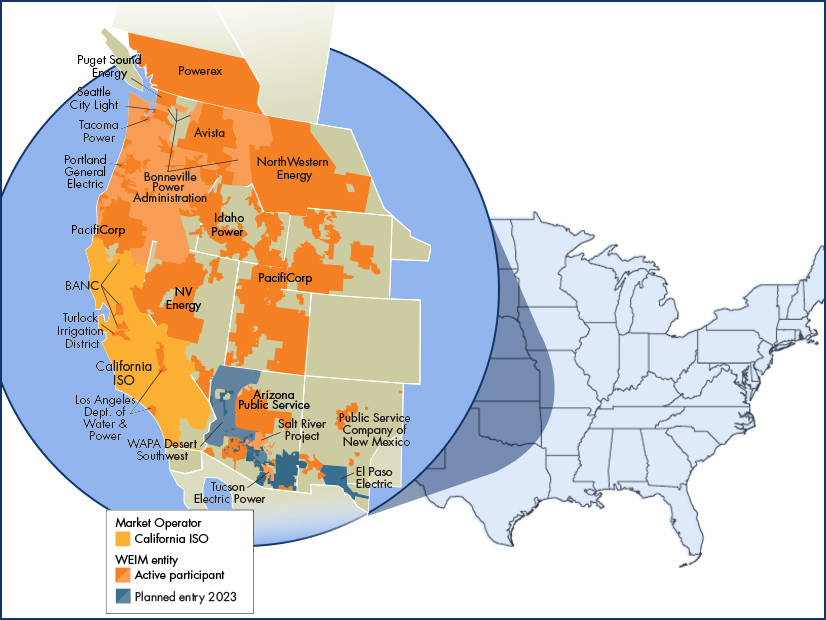
CAISO is moving toward a final plan to add a day-ahead market to its real-time Western Energy Imbalance Market, with the aim of having its Board of Governors and the WEIM Governing Body vote on the proposal in February.
The ISO plans to review a draft plan for the extended day-ahead market (EDAM) in a day-long meeting with stakeholders on Nov. 14. Comments on the final draft are due by Nov. 22, and CAISO expects to publish a final plan in early December.
The draft final proposal published Oct. 31 “reflects significant stakeholder input and design changes” compared with the initial draft in April and a revised proposal in August, CAISO said.
“The draft final proposal is a result of continuing extensive, open and collaborative stakeholder engagement, including more than 500 pages of stakeholder comments on the straw and revised straw proposals and stakeholder discussions during the numerous stakeholder meetings this year,” it said.
Major changes include a requirement that supply offers into the day-ahead market must have “associated transmission reservations.”
“In particular, a resource must be a designated network resource under the terms of the Open Access Transmission Tariff (OATT), have reserved firm point-to-point transmission, or have a legacy transmission contract,” the draft final plan said.
Transmission commitments have been a source of contention in the planning process.
The draft final proposal gives transmission customers and others extra time to plan their daily transmission and resource use by extending the deadline for the voluntarily release of transmission to the market from 6 a.m. to 9 a.m. on the day before delivery.
The plan calls for unscheduled transmission rights to be released to the market to optimize EDAM transfers.
“Stakeholders expressed concern that the timeline for releasing transmission rights to the EDAM … by 6 a.m. the day ahead is too early and may limit the ability of entities to enter into bilateral arrangements,” CAISO said in the draft. “They preferred to move the time closer to 10 a.m. when the day-ahead market runs.”
CAISO compromised with the 9 a.m. day-ahead deadline.
Resource Sufficiency
The EDAM’s resource sufficiency evaluation (RSE) proposal, meant to ensure that participants can meet their own internal needs before engaging in the market, has been another contentious issue during the EDAM design process.
The RSE is needed because balancing authority areas (BAAs) “across the West are not subject to a common resource adequacy or resource planning program” but EDAM must have a “common mechanism to ensure day-ahead supply sufficiency and avoid leaning on the pool of participants by any one EDAM participant,” the draft says.
The draft final proposal deals with the market’s approach to counting firm energy contracts in the day-ahead RSE, a particular area of concern for some stakeholders.
The contracts “are an important component of the supply portfolios of Western load serving entities and have been historically reliable and dependable sources of supply,” it said. But “for these types of firm energy contracts, while the delivery point to a BAA is known, the source and transmission path may not be known in time for the day-ahead market close [at 10 a.m.], when bids are submitted into the market.”
“Given the potential lack of resource and transmission specificity by the time of day-ahead market run at 10 a.m., stakeholders have expressed concerns regarding challenges that these arrangements raise, including the risk of the supporting resource potentially being double counted in how they are offered into the market and potential congestion price implications,” it said.
The draft final plan proposes allowing firm energy contracts to count toward the resource sufficiency evaluation while “strongly [encouraging] identification of the source or source BAA, particularly if it is located in EDAM footprint.”
“If [the] source BAA is not known, the arrangement will be modeled as a self-scheduled injection at the intertie of the sink BAA,” it says.
Tagging requirements, introduced in the revised straw proposal, are also meant to “instill confidence” in firm energy contracts, it said.
A tagging mechanism or “e-tag” is a means of electronically monitoring and recording energy transactions for firm energy contracts. The proposal requires “all non-source-specific forward supply contracts [to] be tagged within three hours following publication of the day-ahead market results.”
Penalties for failing the RSE have been debated repeatedly during the market’s design.
The draft final plan proposes revising the consequences for failing the RSE by including a “tiered structure that provides a tolerance band under which a relatively minor failure does not constitute a resource sufficiency evaluation failure, but failures above the tolerance band are subject to scaled financial administrative surcharges.”

